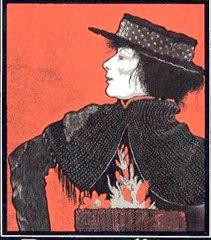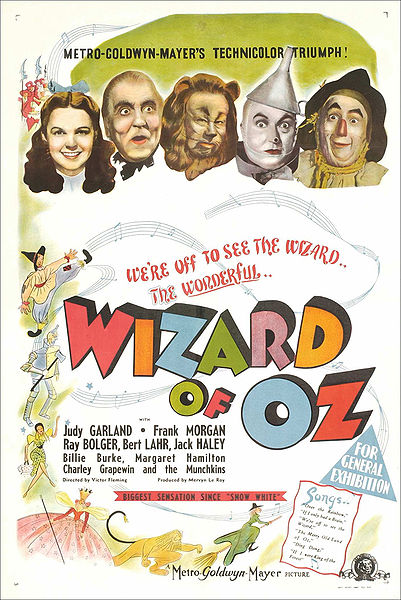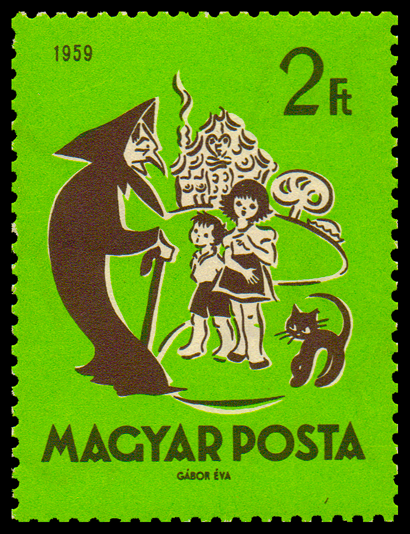In addition to the hero’s journey, other archetypal plot patterns can be found in literature. A few more appear in this section.
Rags to riches

Cover-play1913, Broadwaygal, Wikimedia
The hero or heroine begins poor but noble, and by the end of the story, he or she has wealth, status, and a long happy life. In this archetypal plot, the ordinary world is extreme poverty, and the adventure is the road to riches. The stories of Aladdin and Oliver Twist fit this pattern. The play Pygmalion by George Bernard Shaw is a classic rags-to-riches story. Eliza Doolittle is a poor girl, dressed in rags, selling flowers on the street corner. Professor Henry Higgins bets a friend that he can teach Eliza to pass for a duchess. He succeeds, and while the ending might be slightly ambiguous, one thing is clear: Eliza changes and will never be the poor Cockney flower girl again.
Below you can read an excerpt from the play that illustrates the call to adventure. Henry Higgins (the note taker) has been listening to speech patterns of passers-by and guessing where in London they live. Eliza (the flower girl) is convinced he is an undercover police officer trying to arrest her. Colonel Pickering (the gentleman) has come to London to meet Professor Higgins.
THE GENTLEMAN
(returning to his former place on the note taker’s left)
How do you do it, if I may ask?
THE NOTE TAKER
Simply phonetics. The science of speech. That’s my profession; also my hobby. Happy is the man who can make a living by his hobby! You can spot an Irishman or a Yorkshireman by his brogue. I can place any man within six miles. I can place him within two miles in London. Sometimes within two streets.
THE FLOWER GIRL
Ought to be ashamed of himself, unmanly coward!
THE GENTLEMAN
But is there a living in that?
THE NOTE TAKER
Oh yes. Quite a fat one. This is an age of upstarts. Men begin in Kentish Town with 80 pounds a year, and end in Park Lane with a hundred thousand. They want to drop Kentish Town; but they give themselves away every time they open their mouths. Now I can teach them—
THE FLOWER GIRL
Let him mind his own business and leave a poor girl—
THE NOTE TAKER
(explosively) Woman: cease this detestable boohooing instantly; or else seek the shelter of some other place of worship.
THE FLOWER GIRL
(with feeble defiance) I’ve a right to be here if I like, same as you.
THE NOTE TAKER
A woman who utters such depressing and disgusting sounds has no right to be anywhere—no right to live. Remember that you are a human being with a soul and the divine gift of articulate speech: that your native language is the language of Shakespeare and Milton and The Bible; and don’t sit there crooning like a bilious pigeon.
THE FLOWER GIRL
(quite overwhelmed, and looking up at him in mingled wonder and deprecation without daring to raise her head) Ah—ah—ah—ow—ow—oo!
THE NOTE TAKER
(whipping out his book] Heavens! what a sound! [He writes; then holds out the book and reads, reproducing her vowels exactly) Ah—ah—ah—ow—ow—ow—oo!
THE FLOWER GIRL
(tickled by the performance, and laughing in spite of herself) Garn!
THE NOTE TAKER
You see this creature with her kerbstone English: the English that will keep her in the gutter to the end of her days. Well, sir, in three months I could pass that girl off as a duchess at an ambassador’s garden party. I could even get her a place as lady’s maid or shop assistant, which requires better English. That’s the sort of thing I do for commercial millionaires. And on the profits of it I do genuine scientific work in phonetics, and a little as a poet on Miltonic lines.
Eliza later goes to Henry Higgins and asks him to prove that he can pass her off “as a duchess at an ambassador’s garden party,” and thus her adventure begins.
Journey to the underworld

Source: Wizard of oz movie poster, MGM,
Wikimedia
In this archetypal plot pattern, the hero is transported to another world and back again. The hero doesn’t embark upon the journey with a noble goal but rather is transported to the underworld by accident. After returning to the real world, the hero or heroine has gained important knowledge and a deeper understanding of the world in which he or she lives. For example, in The Wizard of Oz, Dorothy goes to everyone she knows for help with her problems with Miss Gulch, the old schoolmarm who is threatening Dorothy’s dog, Toto. Everyone is too busy to help. They tell her to “use her brain,” “have a heart” about Miss Gulch’s situation, and to “have some courage” and face her problems herself. Dorothy wishes she could be whisked away somewhere “beyond the rainbow,” and her problems would be resolved. Then, Dorothy is whisked off to Oz by a tornado. In Oz, she is faced with several challenges, and at the end of her journey, she learns that the answers to her problems were with her all along. Dorothy learns that running from her problems won’t solve anything. It’s Dorothy’s experience in the “underworld” that changes her.
Overcoming the monster

Source: 1647 FairyTale 200, Darjac,
Wikimedia
In this archetypal plot pattern, the hero becomes aware of a deadly monster that will destroy whoever crosses its path. The hero destroys the monster, thus saving the village, the kingdom, or even the world. Think of the story of “Hansel and Gretel.” Hansel and Gretel are sent into the woods by their parents who can no longer afford to feed them. They come across a house made of sweets, a very old woman who offers them a place to sleep, and some yummy food. The old woman turns out to be an evil witch who intends to fatten Hansel up to eat him and to make Gretel her slave. When the witch decides she wants to eat Gretel too, Gretel tricks her into getting too close to the oven and pushes her in, ridding the world of an evil monster.
Now, try your hand at matching each title to its plot archetype. Drag and drop each title from the left-hand column to an archetype in the right-hand column.
